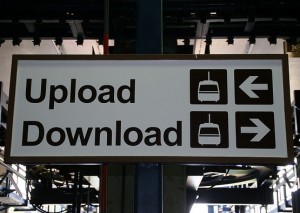
Sending lawyer commercials to television stations and cable companies is a hot topic among cj clients—understandably. In recent years, the cost and scope of this part of the advertising puzzle has flared up to become a significant line item in a given budget. Things have settled down a bit, but it’s still a fluid situation. Hopefully this post will offer some insight into what happens when a commercial spot goes out into the world.
Why do we send spots electronically?
Answering this requires some historical perspective. Back in the day, every time we made a spot, we’d make Beta SP tape copies and ship the dubs to the stations where air time was purchased. It took time, manpower, organization, and storage space, but dubbing-and-shipping was THE standard way of doing things. As a bonus, we became one of FedEx’s favorite customers.
Then everything went digital, and some cool possibilities opened up. Special third-party video services such as DG FastChannel (now Extreme Reach) allowed us to send spots electronically. For the same price as dubbing and shipping a tape, we could upload a commercial faster and more efficiently. Best of all, we could actually send a spot the same day it was scheduled to air, and we didn’t have to maintain a huge, in-house tape library anymore. It was a total win-win.
Needless to say, we sacrificed the holiday fruit basket from FedEx and jumped all over it.
So what caused spot delivery costs to spike?
Two words: high definition.
Because of HD, what had been a simple way of doing business became what we in the South call a “hot mess.” Here’s why. At first, local stations wouldn’t accept HD tapes or files. They continued catering to businesses still clinging to standard def. Then when networks finally took the HD plunge, they chose different formats. Some zigged to 720p; others zagged to 1080i. No matter which format the networks chose, the cost of upgrading was passed on to us. The delivery costs for HD ballooned to more than 30 times the cost of SD! Most of our clients didn’t want any part of it. Who could blame ‘em?
Fortunately, the dust settled. Now, most local stations can handle HD, and thanks to exhaustive bargaining on our part, we’ve negotiated reasonable, albeit elevated, prices:
- The rate for HD is $50 per spot per station.
- SD costs remain $75 per station, and unlimited spots can be sent at one time.
Can’t we bypass third-party video services?
Not really. While it’s true that most stations can accept a file directly, there are no industry standards for how the file is formatted, named, or delivered. Each station has its own specs. In Boston for example, there are six different files that need to be created for each commercial we send. So for a typical 10-spot package, we’d be making 60 files and sending about 120! Remember my “hot mess” comment?
That’s why services like Extreme Reach are indispensable. We can send one video file to them, and they deliver as many copies as we need, in any format, to any station in the world. Using a third-party electronic video service is no longer just a smart choice. In practical terms, it’s the ONLY choice.
Bottom line, whether you pay cj Advertising or a third-party service, it costs money to send commercials to stations. It always has, and as far as we can tell, it always will.
What’s Next?
As the competition heats up, prices could drop some, but probably not much for us. We’ve already negotiated a very competitive deal. Also, the television stations, having already invested heavily in HD, are unlikely to jump on the Ultra High Definition bandwagon anytime soon (yes, that’s a thing).
Here’s what we can say. When it comes to delivering our client’s spots, we will continue to bargain for the cheapest and most efficient way to make it happen.
Photo Credit: John Trainor


